
“Choose a book and do a book report.”
“Write about a country of your choosing.”
“Research a topic and create an outline for your report.”
For many young people, as well as adults, these are terrifying words, signifying an overwhelming assignment and bringing up feelings of anxiety, fear, and even panic!
Written expression is probably one of the most difficult skills to teach. It involves the mechanics of writing:
• punctuation • spelling • grammar • sentence structure
And also requires several other language skills:
• grasp of content
• being able to sequence events in logical order
• using appropriate connecting words, etc.
Most often students are confused about how to get started, or they will say they have a lot of thoughts in their heads but how do they get them on paper? Sometimes, students who can write complete sentences in isolation fall apart when it comes to writing a paragraph or story.
They don’t realize that writing is basically talking on paper!
As with any learning tasks, the trick is to break the assignment down into “handle-able” parts.
I have found that the best way to do that for written expression is to use a visual approach. I call it Information Mapping.
Information Mapping facilitates any type of report or presentation, from simple to complex (such as a thesis), for school, work, or daily life. This includes book reports, essays, letters, research reports, speeches, college writing, business reports, GED or SAT essay test preparation, or even writing a book! It’s also a great technique for memorizing, or studying for tests or any type of workplace promotion exams, which is an added bonus!
Information Mapping works well at all grade levels – kindergarten through college – and in all learning environments – from traditional classroom to homeschool. It’s especially beneficial for students who are thought to have “learning disabilities” or “language processing difficulties.” Not only does this technique facilitate the language skill aspect of writing, it also helps with the mechanics, especially sentence structure and punctuation.
Information Mapping develops the ability to sequence and organize thoughts, which is so important for writing, speaking, and critical thinking!
Information Mapping gives students study skills that they will find useful throughout their school years and beyond, as this powerful technique also aids memory, note taking, and problem solving.
Here are examples of two types of Information Maps.
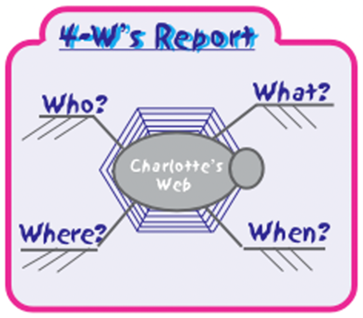

Here is how a simple Brainstorm Map becomes a one-paragraph report – each item in the map is one sentence:

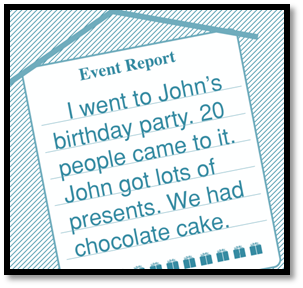
In this more complex map each of the topic items becomes one paragraph, as shown:
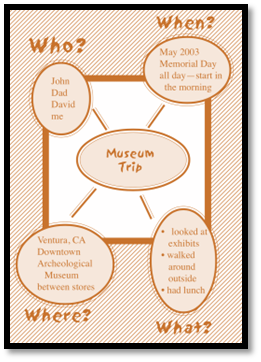
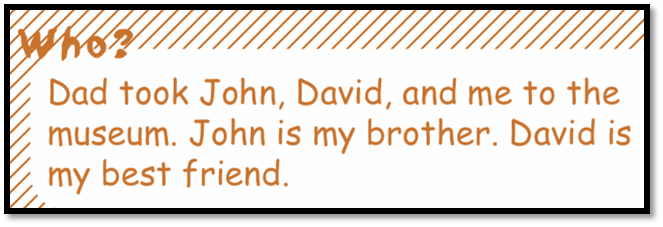
(The examples on this page are taken from the Learning Success Writing Kit, coauthored by M. Willis & V.K. Hodson)
I recommend using unlined paper, sketchbooks, or large easel pads for Information Mapping. Students can add color with crayons or markers, draw pictures, or use stickers.
Information Mapping Curriculum
You can apply the above examples to teach Information Mapping.
For a more step-by-step program, check out the Learning Success Writing Kit that I co-authored for parents and teachers who want more guidance. It’s available here at the coop at a special price for members.
The Learning Success Writing Kit is a curriculum that is set up with daily lessons and can be used in the classroom or at home. It is divided into two parts:
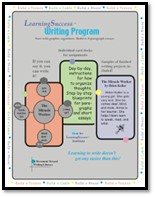 Part 1: Laying the Foundation
Part 1: Laying the FoundationLesson plans for 18 weeks make writing fun for even the most reluctant writers. Part 1 focuses on observation, brainstorming, and organization skills. There is no sentence writing in this part and positive learning experiences are built in. Depending on the age and abilities of the students, Part 1 can be completed in 18 weeks, 36 weeks, or even stretched out over 2 or 3 years.
Part 2: Building on the Foundation—
Blueprints for Paragraphs and Reports
Lesson plans for 36 weeks pick up where Part 1 left off. Using the analogy of building a teepee, a cabin, and house Part 2 guides people of all ages, step by step, in writing sentences, paragraphs, and reports, utilizing the Information Mapping approach taught in Part 1.
Part 2 also teaches how to add introductory and closing sentences, introductory and closing paragraphs, and how to use adjectives, adverbs, and conjunctions to make writing more interesting and colorful.
Learning Success Writing Kit:
Also available at the at the Homeschool Buyers Club: Link-Up™ to Spelling: Weird Words
Spelling doesn’t make sense? This program is for people of all ages who can spell phonetically but don’t get the “weird” words, such as though, friend, said, was, does, etc. – a great program for classrooms, parents who help at home, homeschoolers, and adults. For the picture and hands-on learners spelling has never been so easy and so much fun. Includes blank cards for students to make their own word Link-Ups, laminated reference cards, and lesson plans for 18 weeks.
We want to thank our guest blogger, Mariaemma Willis, M.S, for taking the time to write such an informative post for us.
She also co-developed the Self-Portrait™ Power Traits Assessment, an online tool that provides immediate insights and recommendations for a person’s learning styles.
Would you like to assess your child's learning strengths to create a more effective and enjoyable experience? Save 43% at the Club on The LearningSuccess™ Institute's Self-Portrait™ Power Traits assessment HERE.


